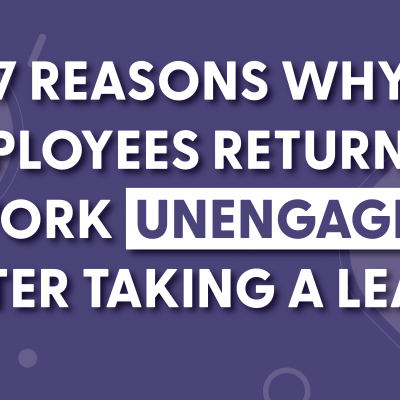Take a deep breath and imagine if you will that you’re an employee. We trust that won’t be too difficult for you to imagine, but we’re not here to judge. Now let’s say you’re an employee, a productive one at that (a big stretch for some), and you’ve just received a text from a sibling that one of your parents has fallen ill and needs your care and support.
You’ve got deadlines. You’ve got responsibilities. You’ve got to figure out if your life outside of work is about to be altered forever. For the first time in your professional career work can wait, and the only thing on your mind right now is to figure out if your company offers caregiving leave and what exactly that entails.
Now imagine you’re in People Ops (hopefully you’ve got this in your imagination repertoire) and you see an email come across your inbox from an employee requesting leave to take care of their sick parent. This was about as far down your list of things you planned to focus on today, but here you are being called to action for support out of the blue.
Are you prepared to help your employee navigate this intricate situation with the urgency and delicacy that’s required?
A leave of absence is often a defining moment in an employee’s life, and the way in which their employer supports them through the journey can make or break the relationship. Even People Ops pros with the best of intentions can fall short when it comes to ensuring their employees get the guidance they need from leave request to reintegration.
So what are the reasons why employees take a leave of absence and return to work unengaged? Let’s break some of these down so you can know what to avoid and ensure your people come back from leave feeling supported and engaged.
1. The Importance of A Reintegration Plan After a Leave
Seemingly by default, a lion’s share of focus with a leave of absence is centered around facilitating the leave request and transitioning them from work-life to life-life. And with good reason, botching the start of a leave of absence puts you in a tremendous employee experience hole to try and climb out of.
That said, nailing the beginning parts of a leave journey but paying little attention to the importance of reintegrating them back into the workforce can negate all the work you put into supporting the leave up to that point.
“Having a re-onboarding plan is very important,” says Kait Feeney, Tilt COO. “Especially for those extended leaves when someone has been out for a long time. Just like you would onboard a new hire, have a plan for welcoming employees coming back from leave.
Employees can feel a great deal of uncertainty when returning to work after an extended leave. Are their projects still on track? Has their team been overworked in their absence? Are they ready to dive back full-bore after their world has been flipped on its head?
To help employees return engaged, work with the employee’s manager to to develop a plan that fits the employee’s circumstance. Kait says, “‘ICYMI docs’ are helpful for when employees return so that they can digest in their own time and ask questions as needed. It isn’t just this ‘hey, welcome back…’ followed by an overwhelming verbal diarrhea of all they missed while they were out.”
2. Leave Shouldn’t Feel Like An Organizational Afterthought
Employers expect a lot from their employees to meet a variety of business needs. Long hours, pressure-filled situations, and meeting the (sometimes unreasonable) demands of clients can all take a toll on any employee’s psyche. And while that can be chalked up to the nature of most jobs, when the roles are reversed and the employee is counting on their employer to come through when they need support, employers can’t afford to miss the mark.
A haphazard approach to leaves of absence sends a signal to employees that their employer may expect them to go above and beyond to sacrifice for the organization, but that this courtesy is a one-way street.
Prioritizing leaves of absence by making the process easy to understand and the journey empathetically supported demonstrates that you view your employees first and foremost as human beings who go through human experiences.
If leaves of absence are viewed as an afterthought in an organization, it shouldn’t be surprising that employees will view their employer as an afterthought and either return unengaged or not return at all.
3. Are Your Leaves Being Supported Consistently?
Want to know something that grinds your employees’ gears? When one employee takes a leave of absence and has an entirely different experience than their colleague. Not only will gears be ground, but your organization could be exposed to legal risks.
If your process for administering leaves isn’t replicable or suffers at scale, employee engagement may be the least of your worries. The inconsistent application of leave policies may lead to claims of discrimination if employees believe they’re being treated unfairly based on protected characteristics such as race, gender, age, disability, or other legally recognized categories.
Inconsistencies in leave administration can negatively impact employee morale as well, which could result in increased turnover, engagement dips, and a generally unhealthy work environment. Can your organization afford the potential repercussions of a single leave of absence being managed inconsistently?
4. Leave of Absence Payroll Perils
Another factor of leaves that is as difficult to get right as it is important to your employees is payroll. A surefire way to breed distrust in your employee population is to mishandle their pay while on a leave of absence. Some employees may be able to forgive a clerical error and be able to absorb a pay miscalculation, others may not.
Pay calculations for a leave of absence don’t require a Master’s in Mathematics (though it wouldn’t hurt), but if you’re manually managing leaves they do require intense attention to detail. In one pay period, your employee might be receiving funds from your company leave policy, personal PTO, a state disability program, and your short-term disability carrier.
That’s four sources of income across 4 systems that all must be calculated with accuracy to ensure your employees’ experience is smooth and their finances are being accurately accounted for. A bad payroll experience might mean your employees can’t make an important payment, or it might result in an overpayment which would require you to ask your employee to pay the company back.
A pro-tip for employee engagement after a leave is to not muck up the money.
5. Employees May Feel Disconnected During A Leave
Communicating with employees on a leave can be a tricky proposition. On one hand, you don’t want managers crossing the line by asking employees on leave inappropriate questions, making reprehensible implications, or straight up asking them to work while on leave.
On the other hand, complete radio silence could be a cold and isolating experience that could cause an employee’s engagement with your organization to drift away. Be mindful that while your employee needs space and privacy while on leave, there are still ways you can make an employee feel connected during their time away from work.
Here are some on-leave communication ideas:
- If their birthday occurs while they’re on leave, send them a happy birthday message from their colleagues to let them know they’re missed
- If big organizational changes occur, keep them in the loop and make yourself available should they have questions (more on this below)
- Perhaps you’re aware that they have a personal relationship with some colleagues. Encourage those colleagues to reach out to check in and periodically say hello.
- Similarly, let managers know they can reach out occasionally (key word there) just to say hello and see how they’re doing
- Have a company-wide event? Invite the employee on leave and make it clear they have no obligation to attend
Keeping an employee connected while on leave can do wonders for an employee’s morale, and have them returning to the fold more energized and engaged.
6. Returning Employees May Still Be Navigating Personal Issues
There are certain aspects of a leave that are outside of your control. If your employees are returning from leave after a particularly trying ordeal there’s the likelihood that they may still be navigating personal issues that could impact their engagement at work.
While it’s outside of your scope as a People Ops leader to heal their pain, it’s important that your organization’s approach to reintegration factors in this very important reality. The weeks provided in your leave policies won’t necessarily line up with the time required to address the very real emotions your employees may be dealing with when they return to work.
If an employee seems unengaged when they return to work, it may not be due to any fault of your own, it might simply be because they’re still processing what’s happening or what has happened in their real life.
In the example we used above, if that caregiver leave turns into a bereavement leave it’s imperative that your organization doesn’t assume that the time allotted for leave is enough to heal their wounds. In this scenario, you can positively impact employee engagement by being patient, empathetic, and understanding of their situation.
In time, your employees will heal, so work with them and their manager on a reintegration plan that makes sense so they aren’t overwhelmed by the workload on day 1. They simply might not be ready and being overloaded out of the gate may cause them to break down and jump ship.
7. Organizational Changes Can Be Disorienting For Employees on Leave
Organizational changes can be extremely disorienting for employees who aren’t on leave, so imagine what it feels like for an employee who is away from work on leave. Here are some ways in which these changes can affect individuals who are temporarily away from the workplace:
- Lack of Information
- Shift in Job Roles and Responsibilities
- Cultural Shifts
- Change in Leadership
- Uncertainty About Job Security
- Altered Team Dynamics
- Changes in Policies and Procedures
It can take some time for an employee to adjust to even one of those items above after returning from a leave. Being faced with all of them at once due to a big shift in your organization can be detrimental to their chances of returning to work engaged in any way.
Communicate with employees on leave any changes to the organization that could impact the landscape of your organization so that they aren’t completely blindsided upon reintegration.
Getting Leave Right For an Engaged Workforce
Leaves of absence can be an isolating and confusing experience for employees who are trying to navigate a significant life moment. An easy and supported leave journey combined with open communication, empathy, and a solid reintegration plan is the best approach to help ensure your employees return from leave feeling the love and support they need during a pivotal time in their lives.
Doing all of this manually takes a monumental lift on People Ops teams, so if you’re concerned about your employees’ well-being and engagement levels when they return from leave, it might be worth looking into dedicated leave software to simplify the process for your employees while providing a consistent and empathetic experience.
About Tilt
Tilt is leading the charge in all things leave of absence management through easy-to-use tech and human touch. Since 2017, our proprietary platform and Empathy Warriors have been helping customers make leave not suck by eliminating administrative burdens, keeping companies compliant, and providing a truly positive and supportive leave of absence experience for their people.







